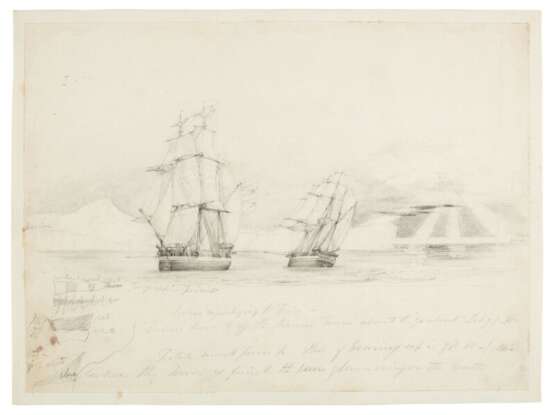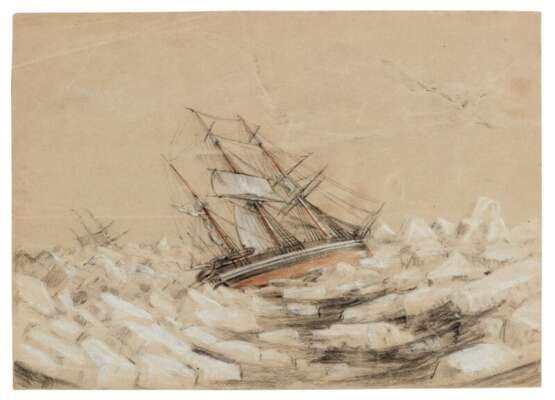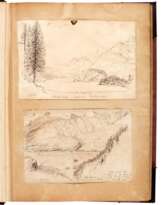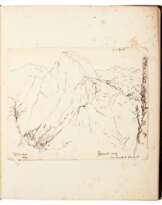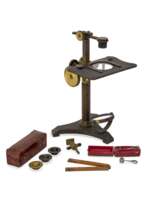Ross Expedition—Joseph Dalton Hooker and others | A portfolio of sketches chiefly relating to Captain James Clark Ross's scientific exploration of the Antarctic in 1839 to 1843
21.09.2023 10:00UTC +00:00
Classic
Starting price
200000GBP £ 200 000
| Auctioneer | Sotheby´s |
|---|---|
| Event location | United Kingdom, London |
Archive
The auction is completed. No bids can be placed anymore.

ID 1028565
Lot 252 | Ross Expedition—Joseph Dalton Hooker and others | A portfolio of sketches chiefly relating to Captain James Clark Ross's scientific exploration of the Antarctic in 1839 to 1843
Estimate value
£ 200 000 – 300 000
CONTAINING APPROXIMATELY 130 SKETCHES IN PEN AND INK, AND WATERCOLOUR, various sizes, mostly extracted from sketchbooks, the majority by Joseph Dalton Hooker, captioned and signed by him, together with three or four each by Fitch, Davis, and Kendall, most captioned on the sheet, additional captions on the mounts by Hooker and others, together with 3 lithographs of Tasmania, mounted in the late nineteenth century on approximately 43 folio card mounts (some mounts dissected), preserved loose with other later ephemera within a late nineteenth century half calf portfolio (522 x 368mm.), marbled boards, some mounts with closed tears at margins, portfolio rubbed with loss at spine
A STRIKING VISUAL NARRATIVE OF ROSS'S SCIENTIFIC EXPEDITION TO THE ANTARCTIC, ONE OF THE GREAT VOYAGES OF DISCOVERY OF THE ERA. THIS REMARKABLE SKETCH-BOOK, NEVER BEFORE SEEN AT AUCTION, INCLUDES DRAWINGS OF ANTARCTIC WONDERS THAT HAD NEVER PREVIOUSLY BEEN SEEN BY HUMAN EYES, AS THE EXPEDITION REACHED FURTHER SOUTH THAN ANY PREVIOUS RECORDED VOYAGE.
Joseph Dalton Hooker (1817-1911) was exultant at being appointed Assistant Surgeon aboard HMS Erebus on James Clark Ross's 1839-1843 expedition to attempt to locate the Magnetic South Pole. Not only would the journey combine Hooker’s passions for travel and botany, and an opportunity to visit the Southern Ocean that he had read about as a boy in Cook’s Voyages, but it was also an opportunity for the ambitious young scientist to make his name. He was following the examples of Charles Darwin, who had been celebrated on his return from his voyage on the Beagle just three years earlier; indeed their mutual friend Charles Lyell gave Hooker proofs of Darwin’s Voyage of the Beagle as inspirational reading matter for his voyage. HMS Erebus and her sister ship HMS Terror travelled for four years, including two seasons exploring the Antarctic. The expedition was thwarted in its object of locating the pole but made huge advances in establishing the contours of the continent of Antarctica, the science of glaciology, and the zoology and – thanks to Hooker – botany of the region.
The present collection of sketches demonstrates Hooker's prodigious talents for geology and botany, with many sketches of geological features, plants, trees, and glaciers, together with topographical views and dramatic images of the ships in the ice and stormy weather. It also traces the journey of HMS Erebus and HMSTerror from England to the farthest ends of the world. The sketches start with a view of Chatham Dockyard from the Erebus, dated 22 July 1839, and a view of the Erebus and Terror in the Medway at Gillingham, dated 24 September 1839, shortly before the expedition departed. This is followed by views of the Erebus and Terror off the Isle of Wight, views of Tenerife and Cape Verde (Nov. 1839), St Paul's Rocks Trindade (January 1840), St Helena (February 1840), Kerguelen's Island, Van Diemen's Land, Mr Macleay's house at Elizabeth Bay (Sydney, Australia), a charming watercolour of Wellington (New Zealand), then just a modest settlement around the natural harbour, and Erebus leaving Port Jackson for New Zealand at the start of her second Antarctic voyage (5 August 1841).
Of greatest interest are the sketches that record the two Antarctic expeditions. One view of the Antarctic continent itself is captioned “First land made of Antarctic continent, Victoria Land”, which was reached in January 1841. The expedition had been following the edge of the pack ice for several days when mountain ranges; Hooker described the scene as one of the most gorgeous he had ever witnessed. On the morning of 12 January 1841 boats made landfall on a nearby island and raised the Union Flag, giving it the name Possession Island, a sketch of which is also found in the album. By early February the expedition was significantly further south than any previous recorded attempt, and this achievement is recorded in a pencil sketch of the two ships under full sail, running between huge icebergs with resting penguins and other fauna in view (“Antarctic Scenery. Lat. 78 South Long. [blank]”). In their second season the expedition travelled even further south, also recorded in a pencil sketch which shows the ships, drawn in careful detail, in a desolate seascape. They spent periods trapped in pack ice – recorded in a coloured drawing – whilst another sketch shows the ships skirting the insurmountable obstacle of the Great Southern Barrier (the Ross Ice Shelf). There are also views of Mount Erebus and Mount Terror, Cape Hooker (by Capt. Davis R.N., Second Master of the Terror), crew members leaving camp in pursuit of a group of penguins on Deception Island (from a sketch by Lieut. Kendall), the balsam-bog quartz rocks in the Falkland Islands watercolour (by Fitch), Cape Horn (1842), and other locations. These were awe-inspiring sights and Hooker reveals the impact of Antarctica’s sublime landscape of the travellers when he describes the first view of Mount Erebus in a letter to his father:
“…at one time we thought we were really going on to the true S. pole, when we were brought up by the land turning from S to E. where there was a fine volcano spouting fire & smoke in 79° S & about 9000 ft high, covered all over with eternal snow except just around the crater where the heat had melted it off. I can give you no idea of the glorious views we have here, they are stupendous & imposing, especially when there was any fine weather, with the sun never setting among huge bergs, the water sky both as blue or rather, more intensely blue than I have ever seen it in the tropics, & all the coast one mass of beautiful peaks of snow & when the sun gets low they reflect the most brilliant hints of golden yellow & scarlet & then to see the dark cloud of smoke tinged with flame rising from the volcano rising in one column, one side jet black & the other reflecting the colours of the sun…” (5 April 1841)
It was of course natural that members of the expedition tried to capture the bleak majesty of the Antarctic with sketches and watercolours. Hooker made a large number of sketches both to preserve a visual record and also for his scientific studies. Some of these will have been made on ship, but others are likely to have been undertaken when the ships were wintering in Hobart. Hooker sent numerous drawings back to his family, and on one occasion explained to his father the circumstances in which he was working: “A separate bundle contains the notes which were all finished in the Ice, where the smooth water enabled me to resume my old post in the Capt[ain]s cabin. As far as I could I imitated Banes's style of drawing dissections, but as the only sketches (on board) of that artist are two in Parry's Voyage, I have not much to copy from & I do not expect that they will please you much, & farther when the ship once gets through a pack she at once meets the troubled waters, & commences rolling about so that I have to lash my portfolio & microscope & to prop myself up […] At present I am attempting a sketch of the ships off the Barrier [Ross Ice Shelf] & burning mountain [Mount Erebus] in 78 South for you, & should I succeed you shall have it; my talent for sketching is however far below par & without colors it would be nothing” (6 July 1841).
One of the most dramatic and dangerous moments of the expedition is also illustrated here, which is the collision of the two ships on 13 March 1842, which almost led to the Erebus being crushed by an iceberg.
| Address of auction |
Sotheby´s 34-35 New Bond Street W1A 2AA London United Kingdom | ||||||
|---|---|---|---|---|---|---|---|
| Preview |
| ||||||
| Phone | +44 (0) 20 7293 5000 | ||||||
| Phone | +1 212 606 7000 | ||||||
| Conditions of purchase | Conditions of purchase |





